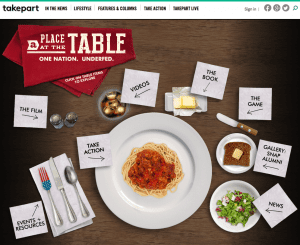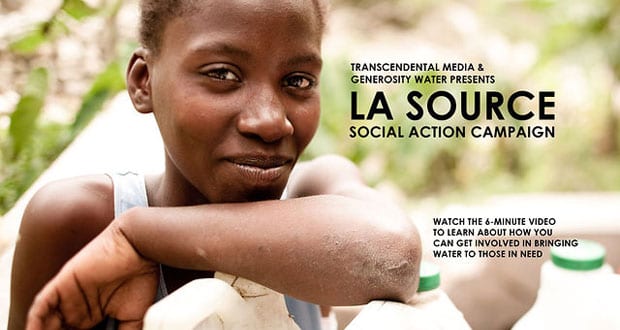Stephen White, MA
Research suggests that the persuasive impact of narratives can be measured by an individual’s absorption into a story, known as transportation theory. This paper examines other research in behavioral measures such as empathy and compassion that could be applied to the content and influence of media social action campaign narratives.
- Citation
- Author
 Stephen White earned his M.A. in Media Psychology at Fielding Graduate University. He is a Fellow at Fielding’s Institute for Social Innovation, and he was awarded an Osherson Fellowship from the Alonso Center for Psychodynamic Studies in 2013. Stephen’s research into media emphasizes the importance of empathy. He leads an independent study for communications majors at Westmont College on the subject of media social action campaigns.
Stephen White earned his M.A. in Media Psychology at Fielding Graduate University. He is a Fellow at Fielding’s Institute for Social Innovation, and he was awarded an Osherson Fellowship from the Alonso Center for Psychodynamic Studies in 2013. Stephen’s research into media emphasizes the importance of empathy. He leads an independent study for communications majors at Westmont College on the subject of media social action campaigns.
Movies and documentaries tell compelling stories that can also raise awareness about social issues. Media companies like Participant Media, Active Voice, and Picture Motion believe that films are a powerful expression for social change. These companies design social action campaigns to drive awareness of important issues in a film, and that also allow the audience to interact, get involved, and take action. According to Picture Motion’s website, they use digital media to raise awareness of upcoming films, hold screenings to engage audiences at the community level, and partner with other organizations, non-profits that already are working in the issue space. The following discussion will present several theoretical models from diverse fields of research to suggest an interdisciplinary approach to examining social action campaigns.
There has been much written about media effects and violence (e.g. Anderson et al., 2004), however researchers have also generalized further into the non-violent effects of media that can be beneficial to society (Buckley & Anderson, 2006). Although this research used video games as the sample media form, others have used the theoretical model, called the General Learning Model (GLM), for other media forms. For example Grietemeyer (2009) suggested the hypothesis that exposure to songs with pro-social lyrics increases pro-social behavior. Grietemeyer first established Anderson’s past research in violent media effects, then argued media exposure may also be a determinant of pro-social behavior, citing the GLM, and prior research into positive effects of television with pro-social content (Sprafkin et al., 1975; corroborated by Mares & Woodward, 2005). There is already precedent for using the GLM as one model to support the positive effects of media. Therefore, it seems to warrant inclusion in a list of models to examine the field of media social action campaigns, and possibly be included in guidelines for creating content.
 According to Bandura’s (1973, 1983) social learning and cognitive theories, we learn either from experience or observation. One of the ways we can learn is by observing people in films and documentaries. At the same time that we observe behaviors we are also learning scripts, which according to Buckley and Anderson (2006), define situations and guide behavior. Well- known scripts are known as knowledge structures. They further claim that learning is a combination of personal and situational or environmental variables. Input variables can make constructs more accessible in memory; they can influence mood and emotion; and the level of arousal can also have an effect on learning. According to Buckley and Anderson, “ behavior is guided by learning, internalizing, and applying scripts” (2006, p. 373). Furthermore, they suggest development of these knowledge structures can change an individual’s personality. As the content of video games matter, e.g. the idea they can teach, we should also pay attention to content in other media forms. Like in the educational use of video games, we can also conclude that social action campaigns can teach and that content matters. We can extrapolate that media exposure to social action campaigns may be a determinant of prosocial behavior.
According to Bandura’s (1973, 1983) social learning and cognitive theories, we learn either from experience or observation. One of the ways we can learn is by observing people in films and documentaries. At the same time that we observe behaviors we are also learning scripts, which according to Buckley and Anderson (2006), define situations and guide behavior. Well- known scripts are known as knowledge structures. They further claim that learning is a combination of personal and situational or environmental variables. Input variables can make constructs more accessible in memory; they can influence mood and emotion; and the level of arousal can also have an effect on learning. According to Buckley and Anderson, “ behavior is guided by learning, internalizing, and applying scripts” (2006, p. 373). Furthermore, they suggest development of these knowledge structures can change an individual’s personality. As the content of video games matter, e.g. the idea they can teach, we should also pay attention to content in other media forms. Like in the educational use of video games, we can also conclude that social action campaigns can teach and that content matters. We can extrapolate that media exposure to social action campaigns may be a determinant of prosocial behavior.
What variables can be input into media social action campaigns? For this approach, we can look to a model of social entrepreneurial intentions developed by Mair and Noboa (2003). According to Mair and Noboa, social entrepreneurs seek opportunities that create organizations or practices that yield social benefits. Social action campaigns also try to create system change ideas with social benefits, so there is a parallel context.
According to Webster’s dictionary, empathy is the ability to share in another’s emotions and feelings. Mair and Noboa consider empathy to be central to their intention-based model. In such models, intentions both motivate and influence behavior. In their model, empathy works in combination with a second cognitive antecedent, moral judgment (a cognitive process that motivates people to help others for the common good), and with enablers such as self-efficacy and social support. In stressing empathy, the researchers concede that no consensus seems to exist on a single definition. Some authors refer to empathy as an affective response, while others suggest it enhances the expression of helping behaviors, and triggers a helping response. Those that agree with the later approach see empathy as the ability to adopt the perspective of other people (Haas, 1984). Mair and Noboa claim that a person who can share another’s emotions and feelings, will develop the desire to help and relieve another’s suffering. Research suggests this trait motivates social entrepreneurs to create social ventures (Prabhu, 1999). One can speculate then, that the behaviors directed toward the formation of a social venture can also positively affect the intention to act for social change, which is an aim of social action campaigns.
A third model to be considered comes from the field of conflict resolution strategies, that being the building of new positive attractors (i.e. social capital), supported by case studies presented by Praskier, Nowak, and Coleman (2010). Praszkier notes sometimes social problems in communities are long lasting because they develop their own stable equilibriums. A paradigm helps explain the stable states (called an attractor) that social systems are drawn to. According to dynamical social psychology, “real change is created by building new attractors toward which the system will drift, rather than by temporarily disrupting the state of system within its old equilibrium” (Praszkier et al., p. 156). Case studies show that small community based initiatives, rather than tackling the issue head on, can lead to the emergence of a new attractor within a community. If that is possible, it may provide a rationale for increasing its use by social action campaigns. Social activists often address situations directly to disrupt the status quo. Over time the result can be neutral (as the system drifts back to the old attractor). According to Martin and Osberg (2007), social entrepreneurs are focused on changing the attractors, and therefore can be a stronger model for social change. This model may also be a stronger model for social action campaigns.
Case studies (see Praszkier et al.) have shown that building social capital develops a higher level of trust and cooperation in communities. It follows that a positive feedback loop is built between an initial success and reinforcement of social capital, strengthening the new attractor. This provides a strong argument for including ways to bring about the creation and enabling of social capital into social action campaigns.
In summary, theoretical models, drawn from the fields of media effects, social entrepreneurship, and social systems theory, can support the examination of media social action campaigns in three ways:
- Demonstrate the media content can have positive effects.
- Suggest that the same individual variables that influence behavior in setting up a social venture, such as empathy, can also be included in media content to influence the audience’s helping behaviors.
- Using the principals of dynamical social psychology in media social action campaigns to develop new attractors and real change.
Furthermore, these models may be applied to social action campaigns as support for triggering helping behaviors, and bringing about social change through bottom up strategies.
 In the area of media social action campaigns, a principle methodology already in use is Transportation theory (Green & Brock, 2000), e.g. by Participant Media, a producer of over forty films and documentaries in the last decade. This theory examines “how recipients are transported into the world of narrative and become involved with its protagonists” (p. 701). The audience can be readers, listeners, viewers, or any recipient of narrative information. Green and Brock define transportation as absorption into a story, and they developed a scale to measure the extent of an individual’s transportation. The theory also supports the power of narratives to change beliefs. Since the mission of Participant Media’s campaigns is “ a good story well told can make a difference in how one sees the world” (2013), it can be said that surveys or questionnaires based on this theory can be used to evaluate the persuasive impact of the social campaign’s narrative to invite the audience to participate.
In the area of media social action campaigns, a principle methodology already in use is Transportation theory (Green & Brock, 2000), e.g. by Participant Media, a producer of over forty films and documentaries in the last decade. This theory examines “how recipients are transported into the world of narrative and become involved with its protagonists” (p. 701). The audience can be readers, listeners, viewers, or any recipient of narrative information. Green and Brock define transportation as absorption into a story, and they developed a scale to measure the extent of an individual’s transportation. The theory also supports the power of narratives to change beliefs. Since the mission of Participant Media’s campaigns is “ a good story well told can make a difference in how one sees the world” (2013), it can be said that surveys or questionnaires based on this theory can be used to evaluate the persuasive impact of the social campaign’s narrative to invite the audience to participate.
The challenges herein to move from theory to application will be to establish metrics that can validate how psychological factors, such as empathy and compassion, can influence the message of such media social action campaigns, and thus help make more of a difference. A brief review of these psychological factors follows below.
There is a considerable amount of interest in empathy, because increased empathy has a lot of positive outcomes (Leitz et al., 2011). Advances in brain imaging indicate that empathy is a process that can be described and measured (Decety & Meyer, 2008). This has been applied to the field of social work, but could have implications beyond. It can be said this could include media social action campaigns, which also informs interpersonal reactions when audiences get involved. There is a model for empathy, the Empathy Assessment Index (EAI), (see Gertz, Leitz, and Segal, 2011). In the literature from social cognitive neuroscience, brain activity has been linked to four experienced components of empathy: affective sharing, self-awareness, perspective taking, and emotion regulation (Decety & Jackson, 2004). Recent research (Gerdes & Segal, 2009) suggests that empathy goes beyond automatic responses. They cite Eisenberg’s idea of “ empathy related responding” (2006, p.71 from Leitz et al., 2011), claiming there is a relationship between empathy and pro-social behavior. The EAI includes empathic attitudes, a component that may increase the likelihood of taking action. This component could be important to the purpose of social action campaigns, the mission of which is to influence the audience to take action. However, researchers concluded that empathic attitude had the lowest inter-correlations with the other components. The empathic attitude component “ was a proxy for commitment to change and action” (Leitz et al., p. 117). They suggest further research is needed to show that action is actually taken. The field of psychology has suggested that empathy is an automatic emotional response to others behavior, however it has also looked into how it can be cultivated (Keltner, 2004). It can be said perhaps that this kind of holistic approach, already relevant to social work, can be utilized in social action campaigns. Development and cultivation of empathy might also provide a component that can measure action.
 One can find a persuasive case for action by testing the variable of compassion, defined as the concern we feel for another person’s welfare (Keltner, 2004). According to Keltner, recent studies in compassion reject self-interest as our dominant feature, but rather we have emotions that are rational, functional and adaptive. His research suggests that compassion is an evolved part of our nature, hard wired into our brain and biology (see Nitschke, 2004). Research by Keltner and Nancy Eisenberg show that compassion is something we can express and understand. According to Batson (1991), when we encounter people in need or distress we feel what that experience is like, and take the perspective of another. This empathic state motivates people to help a person in need. Batson conducted a number of studies in which participants feeling compassion, can also act on it. According to Keltner, if you take the threads of these studies together, research shows that compassion has a biological basis in the brain and body, and it can motivate altruistic behavior. One has to turn to research in positive emotions to find that compassion is more “plastic,” and can be changed by environmental input. This perspective sees compassion as a trait that we can develop, just as empathy is a behavior that can be cultivated (see Roots of Empathy [Gordon, 2002]).
One can find a persuasive case for action by testing the variable of compassion, defined as the concern we feel for another person’s welfare (Keltner, 2004). According to Keltner, recent studies in compassion reject self-interest as our dominant feature, but rather we have emotions that are rational, functional and adaptive. His research suggests that compassion is an evolved part of our nature, hard wired into our brain and biology (see Nitschke, 2004). Research by Keltner and Nancy Eisenberg show that compassion is something we can express and understand. According to Batson (1991), when we encounter people in need or distress we feel what that experience is like, and take the perspective of another. This empathic state motivates people to help a person in need. Batson conducted a number of studies in which participants feeling compassion, can also act on it. According to Keltner, if you take the threads of these studies together, research shows that compassion has a biological basis in the brain and body, and it can motivate altruistic behavior. One has to turn to research in positive emotions to find that compassion is more “plastic,” and can be changed by environmental input. This perspective sees compassion as a trait that we can develop, just as empathy is a behavior that can be cultivated (see Roots of Empathy [Gordon, 2002]).
In conclusion, a number of theoretical models, across research disciplines, have been presented for possible inclusion into a list of ideas that can help make media social action campaigns more effective. This could possibly add to the current methodology being used to assess the influence and impact of these campaigns. It could also be used to create content around a movie’s content, by fine tuning the message to target psychological factors that can persuade audiences, both on site and in public, with developing helping behaviors. Further research is needed into measures of behavior such as empathy and compassion that could be applied to the content and influence of media social action campaigns.
References:
Buckley, K. E., & Anderson, C. A. (2006). A theoretical model of the effects and consequences of playing video games. Retrieved from http://www. psychology.lastate.edu
Green, M.C. & Brock, T.C. (2000). The role of transportation in the persuasiveness of public narratives. Journal of Personality and Social Psychology. 79 (5), 701-721.
Greitemeyer, T. (2009). Effects of songs with prosocial lyrics on prosocial thought, affect, and behavior. Journal of Experimental Social Psychology, 45(1), 1 86-190.
Keltner, D. (2004). The compassionate instinct. Retrieved from: http://greatergood.berkeley.edu/article/item/the_compassionate_instinct/
Lietz, C.A., Gerdes, K. E., Sun, F., Mullins Geiger, J., Wagaman, M. A., Segal, E. A. (2011). The Empathy Assessment Index (EAI). Journal of the Society for Social Work and Research, 2, (2), 104-124.
Mair, J. & Noboa, E. (2003). Social entrepreneurship: how intentions to create a social Enterprise get formed. IESE Business School.
Martin, R. L. & Osberg, S. (2007). Social entrepreneurship: the case for definition. Stanford Social Innovation Review. Spring 2007, p. 33-39. Retrieved from: http://www.ssireview.org/articles/entry/social_entrepreneurship_the_case_for_definition Participant Media (2013). Our mission. Retrieved from http://www.participantmedia.com/company
Praszkier, R., Nowak, A. & Coleman, P.T. (2010) Social Entrepreneurs and Constructive Change: The Wisdom of Circumventing Conflict, Peace and Conflict: Journal of Peace Psychology, 16:2, 153-174.
 Media Psychology Review Journal for Media Psychology
Media Psychology Review Journal for Media Psychology




